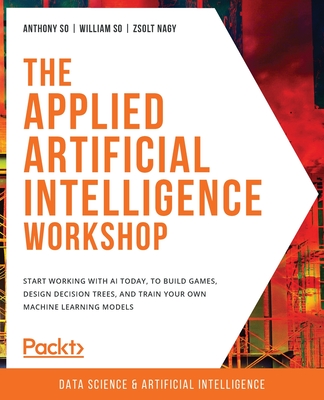Python: Beginner's Guide to Artificial Intelligence: Build applications to intelligently interact with the world around you using Python (Paperback)
暫譯: Python:人工智慧初學者指南:使用 Python 建立智能應用程式與周遭世界互動 (平裝本)
Denis Rothman, Matthew Lamons, Rahul Kumar, Abhishek Nagaraja, Amir Ziai, Ankit Dixit
- 出版商: Packt Publishing
- 出版日期: 2018-12-21
- 售價: $2,050
- 貴賓價: 9.5 折 $1,948
- 語言: 英文
- 頁數: 676
- 裝訂: Paperback
- ISBN: 178995732X
- ISBN-13: 9781789957327
-
相關分類:
Python、程式語言、人工智慧
已絕版
商品描述
Develop real-world applications powered by the latest advances in intelligent systems
Key Features
- Gain real-world contextualization using deep learning problems concerning research and application
- Get to know the best practices to improve and optimize your machine learning systems and algorithms
- Design and implement machine intelligence using real-world AI-based examples
Book Description
This Learning Path offers practical knowledge and techniques you need to create and contribute to machine learning, deep learning, and modern data analysis. You will be introduced to various machine learning and deep learning algorithms from scratch, and show you how to apply them to practical industry challenges using realistic and interesting examples. You will learn to build powerful, robust, and accurate predictive models with the power of TensorFlow, combined with other open-source Python libraries.
Throughout the Learning Path, you'll learn how to develop deep learning applications for machine learning systems. Discover how to attain deep learning programming on GPU in a distributed way.
By the end of this Learning Path, you know the fundamentals of AI and have worked through a number of case studies that will help you apply your skills to real-world projects.
This Learning Path includes content from the following Packt products:
- Artificial Intelligence By Example by Denis Rothman
- Python Deep Learning Projects by Matthew Lamons, Rahul Kumar, and Abhishek Nagaraja
- Hands-On Artificial Intelligence with TensorFlow by Amir Ziai, Ankit Dixit
What you will learn
- Use adaptive thinking to solve real-life AI case studies
- Rise beyond being a modern-day factory code worker
- Understand future AI solutions and adapt quickly to them
- Master deep neural network implementation using TensorFlow
- Predict continuous target outcomes using regression analysis
- Dive deep into textual and social media data using sentiment analysis
Who this book is for
This Learning Path is for anyone who wants to understand the fundamentals of Artificial Intelligence and implement it practically by devising smart solutions. You will learn to extend your machine learning and deep learning knowledge by creating practical AI smart solutions. Prior experience with Python and statistical knowledge is essential to make the most out of this Learning Path.
Table of Contents
- Become an Adaptive Thinker
- Think Like a Machine
- Apply Machine Thinking to a Human Problem
- Become an Unconventional Innovator
- Manage the Power of Machine Learning and Deep Learning
- Focus on Optimizing Your Solutions
- When and How to Use Artificial Intelligence
- Revolutions Designed for Some Corporations and Disruptive Innovations for Small to Large Companies
- Getting Your Neurons to Work
- Applying Biomimicking to Artificial Intelligence
- Conceptual Representation Learning
- Optimizing Blockchains with AI
- Cognitive NLP Chatbots
- Improve the Emotional Intelligence Deficiencies of Chatbots
- Building Deep Learning Environments
- Training NN for Prediction Using Regression
- Generative Language Model for Content Creation
- Building Speech Recognition with DeepSpeech2
- Handwritten Digits Classification Using ConvNets
- Object Detection Using OpenCV and TensorFlow
- Building Face Recognition Using FaceNet
- Generative Adversarial Networks
- From GPUs to Quantum computing - AI Hardware
- TensorFlow Serving
商品描述(中文翻譯)
**開發由最新智能系統進步驅動的實際應用程式**
**主要特點**
- 獲得有關研究和應用的深度學習問題的實際背景知識
- 瞭解改善和優化機器學習系統和算法的最佳實踐
- 使用真實的基於 AI 的範例設計和實現機器智能
**書籍描述**
本學習路徑提供您創建和貢獻於機器學習、深度學習和現代數據分析所需的實用知識和技術。您將從零開始接觸各種機器學習和深度學習算法,並展示如何將它們應用於實際行業挑戰,使用現實且有趣的範例。您將學會利用 TensorFlow 的力量,結合其他開源 Python 庫,構建強大、穩健且準確的預測模型。
在整個學習路徑中,您將學習如何為機器學習系統開發深度學習應用程式。探索如何以分散的方式在 GPU 上實現深度學習編程。
在本學習路徑結束時,您將了解 AI 的基本原理,並完成多個案例研究,這將幫助您將技能應用於實際項目。
本學習路徑包含以下 Packt 產品的內容:
- Denis Rothman 的《人工智慧範例》
- Matthew Lamons、Rahul Kumar 和 Abhishek Nagaraja 的《Python 深度學習專案》
- Amir Ziai 和 Ankit Dixit 的《實作人工智慧與 TensorFlow》
**您將學到的內容**
- 使用適應性思維解決現實生活中的 AI 案例研究
- 超越成為現代工廠代碼工作者
- 理解未來的 AI 解決方案並迅速適應
- 精通使用 TensorFlow 實現深度神經網絡
- 使用回歸分析預測連續目標結果
- 深入使用情感分析探索文本和社交媒體數據
**本書適合誰**
本學習路徑適合任何希望理解人工智慧基本原理並通過設計智能解決方案實際應用的人。您將學會通過創建實用的 AI 智能解決方案來擴展您的機器學習和深度學習知識。具備 Python 和統計知識的先前經驗對於充分利用本學習路徑至關重要。
**目錄**
1. 成為適應性思考者
2. 像機器一樣思考
3. 將機器思維應用於人類問題
4. 成為非傳統的創新者
5. 管理機器學習和深度學習的力量
6. 專注於優化您的解決方案
7. 何時以及如何使用人工智慧
8. 為某些企業設計的革命和對小型至大型公司的顛覆性創新
9. 讓您的神經元運作
10. 將生物模仿應用於人工智慧
11. 概念表示學習
12. 使用 AI 優化區塊鏈
13. 認知 NLP 聊天機器人
14. 改善聊天機器人的情感智力缺陷
15. 建立深度學習環境
16. 使用回歸訓練神經網絡進行預測
17. 用於內容創建的生成語言模型
18. 使用 DeepSpeech2 建立語音識別
19. 使用 ConvNets 進行手寫數字分類
20. 使用 OpenCV 和 TensorFlow 進行物體檢測
21. 使用 FaceNet 建立臉部識別
22. 生成對抗網絡
23. 從 GPU 到量子計算 - AI 硬體
24. TensorFlow Serving















